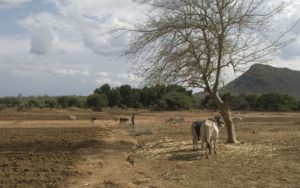ESSP Working Paper 97, by Fantu Bachewe, Feiruz Yimer, and Bart Minten .
Abstract: Expanding and extending an earlier assessment (ESSP Working Paper 88, April 2016), we analyze the evolution of crop and livestock producer prices and wages of unskilled laborers in Ethiopia between January 2014 and June 2016 to evaluate the effect of El Niño triggered droughts – which started in 2015 – that massively impacted parts of the country. The analyses reveal no evidence of widespread adverse price effects of the drought in cereal and labor markets. Real prices of major cereals were lower in the middle of 2016 compared to two years earlier, especially for maize, sorghum, and wheat – the crops that are the major source of calories in areas that were most hit by the drought. The decline in the cost of cereals in the food basket in June 2016 compared to two years earlier was estimated at 12.6 percent at the national level. Moreover, this decline in cereal costs was highest in areas most affected by the drought, possibly indicating the effect of major cereal imports and food aid directed to these areas. Considering crop and livestock prices jointly, the analysis reveals that livestock-cereal terms of trade improved. This is mainly because, although livestock prices declined during this period – as is usually seen in droughts, this decline was less than the decline in prices of cereals in such areas. The fluctuating behavior of cereal prices since January 2015 strikingly contrasts with the El Niño triggered major drought during 1997/98 in Ethiopia. During that period, cereal production declined by 25 percent compared to the year before, with significant increases in real price of cereals, ranging between 15 and 45 percent. In contrast, in 2016 real cereal prices declined, which appears consistent with the relatively larger cereal imports and lower impacts of the drought on national cereal production in 2015/16. Download the PDF.
